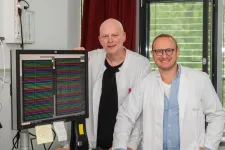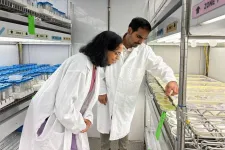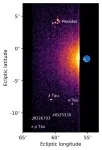(Press-News.org) HOUSTON ―Researchers from The University of Texas MD Anderson Cancer Center have demonstrated that patients with metastatic non-squamous non-small cell lung cancer (NSCLC) harboring specific mutations in the STK11 and/or KEAP1 tumor suppressor genes were more likely to benefit from adding the immunotherapy tremelimumab to a combination of durvalumab plus chemotherapy to overcome treatment resistance typically seen in this patient population.
Study results, published today in Nature, identify KEAP1 and STK11 as potential biomarkers to stratify patients most likely to benefit from the addition of CTLA-4 immune checkpoint inhibitors, including tremelimumab.
In these patients, adding tremelimumab to durvalumab and chemotherapy resulted in higher overall response rates (42.9%) relative to patients who received durvalumab plus chemotherapy (30.2%) or chemotherapy alone (28%). These findings were further substantiated in preclinical models, supporting the use of dual checkpoint inhibitors for patients with these mutations.
"STK11 and KEAP1 alterations are common in patients with NSCLC and are linked to poor clinical outcomes with current standard-of-care first-line treatments," said co-lead author Ferdinandos Skoulidis, M.D., Ph.D., associate professor of Thoracic/Head and Neck Medical Oncology "While prior research suggested potential benefits from adding CTLA-4 inhibitors to PD-1 or PD-L1 inhibitors, we have no reliable biomarkers to predict which patients would see the best outcomes. This study provides the strongest evidence to date that patients with STK11 and/or KEAP1-mutated NSCLC may selectively benefit from dual immune checkpoint inhibition."
This research study – made possible by collaboration between 22 academic centers in North American and Europe as well as biotechnology and pharmaceutical companies – combines analyses of clinical cohorts, patient samples, laboratory models and data from the Phase III POSEIDON clinical trial.
Initial observations in a clinical cohort of 871 patients with NSCLC demonstrated that patients with STK11 and/or KEAP1 alterations had poorer outcomes with chemotherapy plus the PD-1 inhibitor pembrolizumab. Researchers went on to study the immune and genetic characteristics of 8,592 non-squamous NSCLC tumors. They found that mutations in the STK11 and KEAP1 genes were linked to a less favorable tumor environment, often referred to as a "cold" microenvironment. This type of environment had many suppressive myeloid cells and fewer CD8+ cytotoxic T cells, which are important for fighting tumors. However, they noted that CD4+ immune cells were less impacted and remained present in tumors with STK11 and/or KEAP1 mutations.
Based on these observations, the researchers hypothesized that dual checkpoint inhibitors, targeting CTLA-4 in addition to PD-1 or PD-L1, may improve outcomes. In an analysis of 1,013 patients from the POSEIDON study, the researchers confirmed tremelimumab plus durvalumab and chemotherapy improved responses rates, progression-free survival and overall survival.
To further expand on these findings, experts then evaluated the effects of single and dual immune checkpoint inhibition on the tumor microenvironment in multiple preclinical models of STK11 and/or KEAP1-mutated NSCLC. Compared with PD-1 inhibition alone, dual checkpoint blockade strongly improved the tumor microenvironment by increasing the presence of specific immune cells that boost the antitumor response, providing a possible mechanism that may explain the observed benefits.
"These findings support that NSCLC patients with STK11 or KEAP1 mutations are relatively resistant to standard combinations of PD-(L)1 inhibitors and chemotherapy, but can benefit markedly when a CTLA-4 inhibitor is added to their treatment regimen," said co-lead author John Heymach, M.D., Ph.D., chair of Thoracic/Head and Neck Medical Oncology. "We are optimistic that these results will prompt clinicians to consider this novel therapeutic approach as a preferred treatment option."
Limitations of this study include the fact that some of the results were analyzed after the study was completed, as well as the limited number of patients with STK11 and/or KEAP1 alterations. In the ongoing Phase IIIB TRITON trial, researchers will prospectively compare dual checkpoint blockade with durvalumab and tremelimumab versus pembrolizumab in combination with chemotherapy in patients with advanced non-squamous NSCLC with STK11, KEAP1 or KRAS alterations.
This research was supported by the National Institutes of Health/National Cancer Institute (P50 CA070907, 1R01 CA262469-01, 1R01 CA279452-01A1, R01 CA205150, CA016672, 1S10OD024977-01, P30 CA016672, P30 CA016058, P30 CA008748), the Cancer Prevention and Research Institute of Texas (RP160652), MD Anderson’s Lung Cancer Moon Shot®, Stand Up to Cancer, The Mark Foundation for Cancer Research, The Gordon A. Cain Foundation, Gunnigar Fund, Andrea Mugnaini Lung Cancer Research Fund, Ford Petrin Fund, Rexanna’s Foundation for Fighting Lung Cancer, and the David Bruton, Jr. Chair endowment.
A full list of acknowledgements, collaborating authors and their disclosures can be found here.
Read this press release in the MD Anderson Newsroom.
END
Dual immunotherapy plus chemotherapy benefits specific subset of patients with lung cancer
Study finds patients with advanced non-small cell lung cancer and STK11 and/or KEAP1 mutations had improved outcomes with combination treatment
2024-10-09
ELSE PRESS RELEASES FROM THIS DATE:
Scientists discover viral trapdoor blocking HIV and herpes
2024-10-09
Scientists discover viral trapdoor blocking HIV and herpes
Ghent, 10 October 2024 – A group of researchers led by Xavier Saelens and Sven Eyckerman at the VIB-UGent Center for Medical Biotechnology discovered how a protein linked to the human immune system wards off HIV-1 and herpes simplex virus-1 by assembling structures in the cell that lure in these viruses and then trap them or even take them apart. The research was spearheaded by first author George Moschonas, published in Cell Host and Microbe, and could be used to devise new strategies to combat these viruses.
The innate immune system of the human body can sense and respond to viruses by ...
Study uncovers mutations and DNA structures driving bladder cancer
2024-10-09
How bladder cancer originates and progresses has been illuminated as never before in a study led by researchers at Weill Cornell Medicine and the New York Genome Center. The researchers found that antiviral enzymes that mutate the DNA of normal and cancer cells are key promoters of early bladder cancer development, and that standard chemotherapy is also a potent source of mutations. The researchers also discovered that overactive genes within abnormal circular DNA structures in tumor cells genes drive bladder cancer resistance to therapy. These findings are novel insights into bladder cancer biology and point to new therapeutic strategies for this ...
A matter of taste: Electronic tongue reveals AI inner thoughts
2024-10-09
UNIVERSITY PARK, Pa. — A recently developed electronic tongue is capable of identifying differences in similar liquids, such as milk with varying water content; diverse products, including soda types and coffee blends; signs of spoilage in fruit juices; and instances of food safety concerns. The team, led by researchers at Penn State, also found that results were even more accurate when artificial intelligence (AI) used its own assessment parameters to interpret the data generated by the electronic tongue.
The researchers published their results today (Oct. 9) in Nature.
According to the researchers, ...
Another step towards decoding smell
2024-10-09
We often only realize how important our sense of smell is when it is no longer there: food hardly tastes good, or we no longer react to dangers such as the smell of smoke. Researchers at the University Hospital Bonn (UKB), the University of Bonn and the University of Aachen have investigated the neuronal mechanisms of human odor perception for the first time. Individual nerve cells in the brain recognize odors and react specifically to the smell, the image and the written word of an object, for example a banana. The results of this study close a long-standing knowledge gap between animal and human odor research and have now been published in the renowned ...
Plant Science Research collaboration will explore key mosses critical to storing carbon
2024-10-09
ST. LOUIS, MO, October 9, 2024 - Plant scientists at the Donald Danforth Plant Science Center and the HudsonAlpha Institute for Biotechnology have been awarded a four-year National Science Foundation (NSF) Enabling Discovery through GEnomics (EDGE) grant to advance their understanding of sphagnum moss, a crucial component of peatlands and a vital player in global ecosystems. The collaborative research team will develop genetic and genomic resources to study sphagnum's life cycle, growth, and adaptation to various environmental conditions.
Sphagnum ...
Researchers examine the persistence of invisible plastic pollution
2024-10-09
Plastic pollution – tiny bits of plastic, smaller than a grain of sand – is everywhere, a fact of life that applies even to newborn rodents, according to a Rutgers Health study published in the journal Science of the Total Environment.
Researchers have long understood that micro- and nanoplastic particles (MNPs), which enter the environment through oxidation and natural degradation of consumer products, are easily deposited in the human body through inhalation, absorption and diet.
Experts also understand that these pollutants can cross the placental barrier and deposit ...
Coffee during pregnancy safe for baby’s brain development
2024-10-09
A University of Queensland-led study has failed to find any strong links between drinking coffee during pregnancy and neurodevelopmental difficulties in children, but researchers are advising expectant mothers to continue following medical guidelines on caffeine consumption.
Dr Gunn-Helen Moen and PhD student Shannon D’Urso from UQ’s Institute for Molecular Bioscience (IMB) led an in-depth genetic analysis of data from tens of thousands of families in Norway.
“Scandinavians are some of the biggest coffee consumers in the world, drinking at least 4 cups a day, with little stigma about drinking coffee during pregnancy,” ...
SwRI-led instrument aboard Jupiter-bound spacecraft nails in-flight test
2024-10-09
SAN ANTONIO — October 9, 2024 —As European Space Agency (ESA)’s Jupiter Icy Moons Explorer (Juice) spacecraft hurtled past the Moon and Earth in mid-August to provide its first gravity assist maneuver to the Jovian system, the Southwest Research Institute-led Ultraviolet Spectrograph (UVS) instrument imaged the UV emissions radiating from the Earth and Moon.
It was a successful test of one of three science instrument projects comprising NASA’s contribution to ESA’s Juice mission. The UVS data collected were then analyzed and found to be consistent with expectations for the Moon and the Earth. This confirmation that the instrument works ...
New AI models of plasma heating lead to important corrections in computer code used for fusion research
2024-10-09
New artificial intelligence (AI) models for plasma heating can do more than was previously thought possible, not only increasing the prediction speed 10 million times while preserving accuracy, but also correctly predicting plasma heating in cases where the original numerical code failed. The models will be presented on October 11 at the 66th Annual Meeting of the American Physical Society Division of Plasma Physics in Atlanta.
“With our intelligence, we can train the AI to go even beyond the limitations ...
Study: Rise in English learner students in “new destination” states helps, does not hurt, academic outcomes for existing students
2024-10-09
Washington, October 9, 2024—English learner (EL) students represent the fastest growing student group in the United States over the past two decades, with numbers of EL students in public schools soaring in “new destination” states across the South and Midwest. Some commentators have expressed concerns about the possible adverse effect of immigrant students on current students if they require additional resources that are diverted from their peers.
However, a new study finds significant positive spillover effects ...
LAST 30 PRESS RELEASES:
Boosting the cell’s own cleanup
Movement matters: Light activity led to better survival in diabetes, heart, kidney disease
Method developed to identify best treatment combinations for glioblastoma based on unique cellular targets
Self-guided behavioral app helps children with epilepsy sleep earlier
Higher consumption of food preservatives is associated with an increased risk of type 2 diabetes
NTU Singapore-led team captures first-ever ‘twitch’ of the eye’s night-vision cells as they detect light, paving the way for earlier detection of blindness-causing diseases
Global aviation emissions could be halved through maximising efficiency gains, new study shows
Fewer layovers, better-connected airports, more firm growth
Exposure to natural light improves metabolic health
As we age, immune cells protect the spinal cord
New expert guidance urges caution before surgery for patients with treatment-resistant constipation
Solar hydrogen can now be produced efficiently without the scarce metal platinum
Sleeping in on weekends may help boost teens’ mental health
Study: Teens use cellphones for an hour a day at school
After more than two years of war, Palestinian children are hungry, denied education and “like the living dead”
The untold story of life with Prader-Willi syndrome - according to the siblings who live it
How the parasite that ‘gave up sex’ found more hosts – and why its victory won’t last
When is it time to jump? The boiling frog problem of AI use in physics education
Twitter data reveals partisan divide in understanding why pollen season's getting worse
AI is quick but risky for updating old software
Revolutionizing biosecurity: new multi-omics framework to transform invasive species management
From ancient herb to modern medicine: new review unveils the multi-targeted healing potential of Borago officinalis
Building a global scientific community: Biological Diversity Journal announces dual recruitment of Editorial Board and Youth Editorial Board members
Microbes that break down antibiotics help protect ecosystems under drug pollution
Smart biochar that remembers pollutants offers a new way to clean water and recycle biomass
Rice genes matter more than domestication in shaping plant microbiomes
Ticking time bomb: Some farmers report as many as 70 tick encounters over a 6-month period
Turning garden and crop waste into plastics
Scientists discover ‘platypus galaxies’ in the early universe
Seeing thyroid cancer in a new light: when AI meets label-free imaging in the operating room
[Press-News.org] Dual immunotherapy plus chemotherapy benefits specific subset of patients with lung cancerStudy finds patients with advanced non-small cell lung cancer and STK11 and/or KEAP1 mutations had improved outcomes with combination treatment







